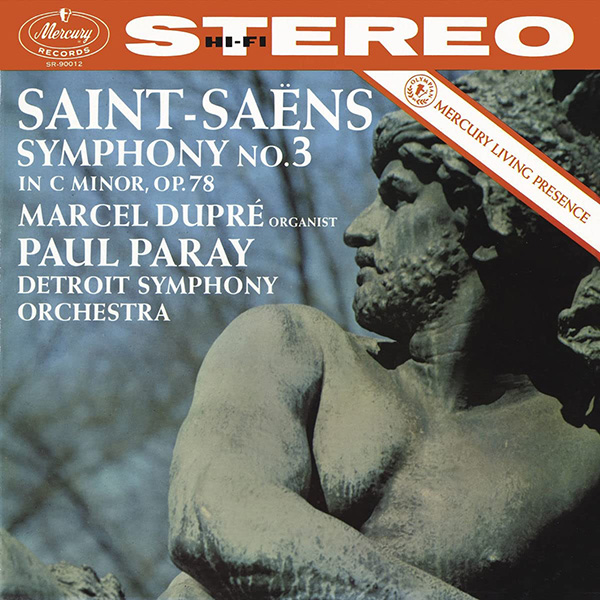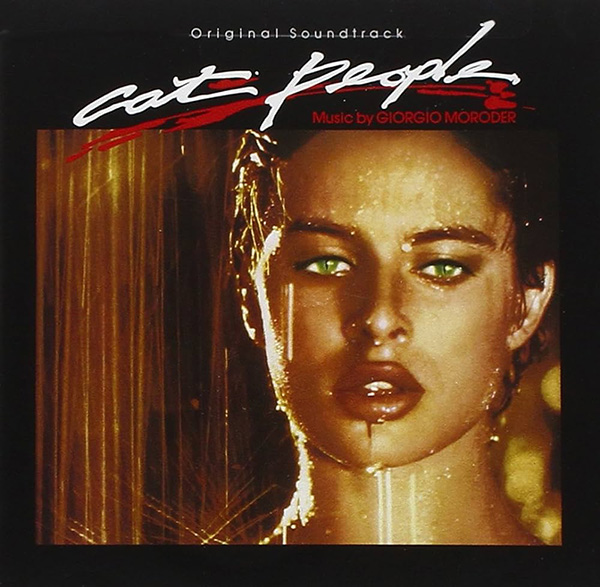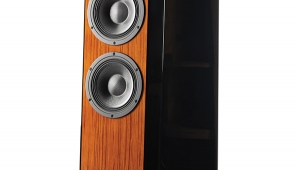| Columns Retired Columns & Blogs |
Snell B minor loudspeaker Page 2
Next I checked for bass extension. With César Franck's Chorale No.1 for pipe organ (Marcel Dupré, Mercury Living Presence 434 311-2), the Snell B minors sustained the deep growl of the organ pedals and shook the room. The B minors had ample bass dynamics, as shown by their rendition of the powerful bass drum in Owen Reed's La Fiesta Mexicana (Fiesta, Reference RR-38CD). At the same time, the clarity of the upper registers was maintained. On the My Cousin Vinny soundtrack (Varèse Sarabande VSD-5364), the Mark Levinson No.27.5 delivered ample amounts of subterranean bass on Randy Elman's "Something's Wrong," but did not muddy the keyboard notes.

However, the B minors' bass did not equal the extension heard with the Type B, which has a built-in subwoofer. The stair-step descent of organ notes on Saint-Saëns's Symphony 3 (Marcel Dupré, organ; Paul Paray, Detroit Symphony; Mercury Living Presence 432 719-2) was best heard through the Bs with the Krell KSA-250, or with the Muse Model 18 subwoofer coupled to Quad ESL-63s. The B minors' woofers played a few notes at the beginning of the descending scale, but did not reach as low as the Bs or the dedicated, biamped subwoofer. This is to be expected, and is not a fault of the B minors.
The better-balanced low frequencies of the B minor mean that the bass does not interfere with instruments playing in the other parts of the sonic spectrum, as it does in the Type B. The B minor, however, can separate the flute, Maggie Boyle's soprano, and the 35Hz bass synthesizer chords on "Main Title," from the Patriot Games soundtrack (RCA 66051-2). There was an effortlessness, such that even the most dramatic fortissimo orchestral selections, and the loudest sections of Jeff Beck's "Behind the Veil," retained their senses of air and acoustical space. Richard Thompson's voice on Rumor & Sigh, clear and untarnished by the kickdrum, floated between the B minors—well-defined and almost palpable.
Was the bass of the B minor amplifier-sensitive? To a certain extent, yes. The Krell KSA-250 proved again to be lean in the midbass where the B minor was not, and this produced a good balance. The Krell KSA-250 delivered open, spacious sound, with wonderful depth and space on choral works. Both the Class;ae 15 and the Mark Levinson No.27.5 played with vividness, speed, and bass definition, but not with the openness of the KSA-250.
If the KSA-250 "controlled" the B minor's bass, did tube amplifiers, with their higher output impedances, worsen or exaggerate the mild bass prominence? The Woodside M-50 monoblocks, which have a 0.3 ohm output impedance, did not change the B minors' tonal balance. The Woodsides produced exceptionally smooth sound with an even wider soundstage than the KSA-250 did, yet did not cause the bass to become congested, swollen, or fat. Their 50Wpc maximum power ratings were limitations, however. These tube amps ran out of steam when the B minors were playing rock music or movie scores at high spls.
However, both the Type Bs and the B minors lacked transient speed in the bass. Bass impulses were blurred and smoothed compared to the shock waves that the Snell Type A/III Improved or the Velodyne ULD-18 can deliver on bass-drum whacks or sudden synthesizer chords. The Snell Type A/III Improved, playing the beginning of Dorsey's "Ascent" (Time Warp, Erich Kunzel & the Cincinnati Pops, Telarc CD-80106), startled me with the explosive opening synthesizer chord. The B blurred and softened the note, removing all its slam and impact.

Despite this lack of transient bass speed, the B minors have plenty of pace, as evidenced in listening to Giorgio Moroder's score for Cat People (MCA MCAD-1498). If playing track one—David Bowie's "Putting out the Fire"—on the B minors doesn't make you get up and dance, nothing will. Pace was also evident on "Assault on Ryan's House," from Patriot Games—composer James Horner tightens the emotional screws by mixing a variety of unusual rhythmic effects, including a synthesizer-generated one that sounds like a jet engine mixed with bass-drum whacks.
The B minor's midrange response contributed to its ability to image, producing a soundstage of considerable depth. My standard CD selections showed that the B minors' soundstage was able to hold its own with those of more expensive designs, like the Quads. On the Stereophile Test CD, the B minors placed the post-performance "Well done!" at the extreme left-hand stage—an accurate re-creation of the soundstage perspective. Similarly, Larry Archibald's voice on track 10 of Stereophile's Test CD 2 changed its apparent location in my listening room, as intended (see Vol.15 No.6, p.202). The B minors' imaging abilities can be heard at the very end of Richard Thompson's "Why Must I Plead," when the sonic image of Thompson's acoustic guitar plays just to the right of the right speaker. The B minors' back-to-front depth of imaging helped render a sense of the hall on Shostakovich's Symphony 6 (Leopold Stokowski, Chicago Symphony, RCA LSC-3133).
The B minor's prominent midrange produced a "forward" sound. Female vocalists sounded up-front and close. Sinead O'Connor's voice on Peter Garland's "Don't Give Up," from Willie Nelson's Across the Borderline, is one of the most challenging to bring out. O'Connor sings with a tiny, thin, thread-like voice that's compelling, and dramatically undercuts Nelson's rich tone. On the B minors, O'Connor's voice retained its character and was easily heard. Not so with other loudspeakers. For example, the colorations of the Charios damped and muted her voice so that it was barely audible.
The B minor's treble response was excellent, showing an ability to produce open, effortless highs. Driven this time by the Mark Levinson No.27.5, the B minors played Prokofiev's Romeo & Juliet, Suites 1 & 2 (Stanislav Skrowaczewski, Minneapolis Symphony, Mercury Living Presence 432 004-2) with a considerably deep, transparent, detailed, up-front string tone. This extension was evident on the LP version of the Glory soundtrack (Virgin 90531-1). In the opening cut, "A Call to Arms," the choir voices were spread from wall to wall and had considerable depth. The sound of the vibes on Joe Beck's "Unspoken Words," from The Journey (DMP CD-481), remained detailed, clear, and open.
Comparisons
Compared with the Snell A/III or the Quad ESL-63/Muse Model 18 combination, the B minor didn't extend as low in the bass; the midrange-presence effect made it sound more aggressive and forward. The bass was not as fast or as capable of delivering the hardest "slam"; the B minor continued to have a bass emphasis in the 40–60Hz range.
The Quad/Muse system, currently retailing for $7000, plays with greater speed and more transparency, midrange neutrality, and a wider soundstage. The $2500 Muse Model 18 subwoofer optimizes the response below 50Hz, yielding the best overall rendition of deep bass. This reference combination is capable of rendering the deepest organ notes, which are played at the beginning of the cadenza on Saint-Saëns's "Organ Symphony" LP (Eugene Ormandy, Columbia MS 6469). E. Power Biggs holds each note for about two seconds as he plays a descending scale. With the Muse, each note sounded as if it was a step on a staircase, with clean pitch and putting "a lock" on the room. The B minor/Krell KSA-250 combination did not reach as low, nor did it have the Muse's pitch definition. Through the Quad system the Stokowski/Chicago Symphony recording had an enormous, seamless soundstage that reached almost beyond the walls of the listening room. The Quad system was less compressed and more dynamic-sounding than the B minor.
The Snell Type A/III Improved loudspeaker ($5890/pair when it was last available) shared two of the B minor's characteristics: wide dynamic range and pellucid treble response. Its low frequencies had better pitch definition, however, and its soundstage was wider and more panoramic. On the other hand, the A/III was not as transparent as the B minor; its wall-to-wall soundstage didn't have the B minor's image depth.
LG Sums Up
The Snell B minor does not suffer from the exaggerated bass that many of Stereophile's writers heard with the Type B. The B minor's redesigned midrange and treble sections give the loudspeaker better soundstage depth and overall transparency, even though the speaker has more midrange "presence." It's much easier to optimally set up the B minors.
At its $3599/pair price, the B minor encounters stiff competition, including the Thiel CS3.6 ($3990/pair), the Apogee Centaur Major ($3785/pair), and the Acarian Alón IV ($3400/pair). However, the B minor's transparency and imaging win it a "B" recommendation in "Recommended Components." While its bass is still prominent, the overall tonal balance is more pleasing than the B's. The B minor's trim tower configuration, easy setup, match with a wide range of amplifiers, good price point, wide dynamic range, and transparency will be key points for those interested in a full-range, floorstanding dynamic loudspeaker.
- Log in or register to post comments




































